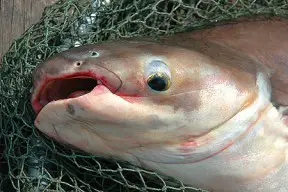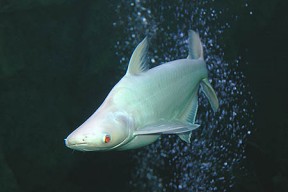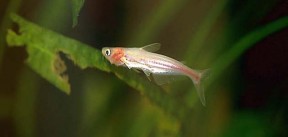Pangasionodon hypophthalmus
Iridescent Shark Catfish
Classification
Pangasiidae
Distribution
Native to the lower Mekong river running through Thailand, Laos, Cambodia and Vietnam. It’s also found in the Chao Phraya river in Thailand. Most of the fish available in the trade have been mass-bred for the purpose, and it’s also cultivated for food in most of its native countries.
Habitat
It’s a pelagic species inhabiting main river channels and larger tributaries.
Maximum Standard Length
52″ (130cm), and over 40 kg in weight. Although it rarely reaches this size in captivity, it’s easily capable of topping 36″ (90cm).
Aquarium SizeTop ↑
Unsuitable for all but the very largest tanks. It’s a very active open water species and tends to be skittish when kept in cramped conditions. This can lead to problems with the fish banging into the tank glass and items of decor, often resulting in injury. For even a single specimen to be housed long term a tank measuring at least 15′ x 6′ x 6′ (450cm x 180cm x 180cm) – 14,580 litres would be the minimum needed. Juveniles can of course be grown on in smaller tanks.
Maintenance
Strictly speaking, decor isn’t necessary for a tank containing an adult, provided the lighting is fairly dim. You can however add some large chunks of bogwood, beech branches or smooth rocks if you wish. Ensure that any such furnishings are too heavy to be moved around or secured to the tank in some way, and that there’s plenty of open swimming space. Well-oxygenated, flowing water is also recommended as it’s a riverine species by nature.
A large and efficient biological filter is needed to cope with the amounts of waste produced by a fish of this size. If possible choose a sump–type arrangement, as this allows most of the equipment to be located outside the tank. A large specimen can easily destroy glass heaterstats, thermometers etc. The tank must also be fitted with a suitably-sized, heavy cover as it occasionally breaches the surface during bouts of nervous behaviour.
Water Conditions
Temperature: 72 to 79°F (22 to 26°C)
pH: 6.5 to 7.5
Hardness: As the species' natural waters are subject to annual flooding, water parameters can vary considerably over the course of each year. General hardness is thus not critical, and anywhere in the range 2-30°H should be acceptable.
Diet
It’s omnivorous, although a juvenile will require a good amount of protein in the diet in order for it to develop and grow at the correct rate. Offer a varied diet consisting of chopped earthworm, bloodworm and dry pelleted foods. As it gets older it will need a greater proportion of vegetable matter and items such as spinach leaves, frozen peas (just drop these straight into the tank), Spirulina-based dry foods and even the occasional slice of fruit can be introduced.
Behaviour and CompatibilityTop ↑
Not an aggressive species, but much smaller tankmates will likely be consumed. It can also bother sedentary or shy companions with its constant activity, but conversely is easily intimidated by aggressive or boisterous species. The best choices are large, peaceful benthic and mid to upper water shoaling species. Doradids such as Oxydoras niger, Megalodoras urunoscopus or Pterodoras granulosus are ideal, as are Pacu or many larger cyprinids.
It’s a shoaling species by nature and will be less flighty when maintained in a group. Obviously a truly enormous tank would be needed to adequately house several.
Sexual Dimorphism
Supposedly females are stockier and have lighter patterning than males. At the size it’s usually seen for sale these differences are impossible to detect.
Reproduction
It’s a migratory species, moving upstream to spawn during the late spring and summer months. Obviously these conditions are virtually impossible to replicate in the home. Coupled with the massive size of sexually mature fish, it would seem that aquarium breeding is unlikely to be achieved. It’s being bred commercially in huge ponds on Far Eastern fish farms, though.
NotesTop ↑
Previously referred to as Pangasius sutchi, this is the commonest of the Pangasiid catfish seen in the aquatic trade. It’s usually seen for sale as a cute silvery-blue 2-3″ youngster, most often without adequate information regarding its long term care requirements and potential size. Unfortunately this means it makes it’s way into many a beginner’s community tank, as it’s undeniably attractive when small. The use of common names such as the one stated here don’t help this undesirable situation, being designed as they are to increase sales. There are even a few selectively-bred strains produced specifically for the aquarium trade. Particularly popular are the albino and grossly disfigured ‘shortbody/balloon’ forms. This latter form remains significantly smaller than the natural fish.
In reality it’s debatable as to whether the species should be considered an aquarium subject at all. While Pangasius rarely reach their maximum size in captivity, they’re still easily capable of growing to a few feet in length. The myth that fish will only grow to match the size of the tank they’re kept in is just that.
It’s also worth noting that it can live for around 20 years or more, making it a considerable long-term commitment. Some aquarists buy a young specimen with the intention of buying a bigger tank as it grows. However due to life’s unpredictable nature very few actually take this step, instead attempting to rehome the fish. Public aquaria are already inundated with far too many ‘cast offs’ from the hobby, and are unlikely to take a big one off your hands. Very few fellow hobbyists will have the facilities to do so, either. It’s sad to think how many hundreds of these are doomed to a drastically shortened existence by the aquatic trade. Please don’t buy one unless you’re in that select group of aquarists with the resources required to house it for life already in place.




